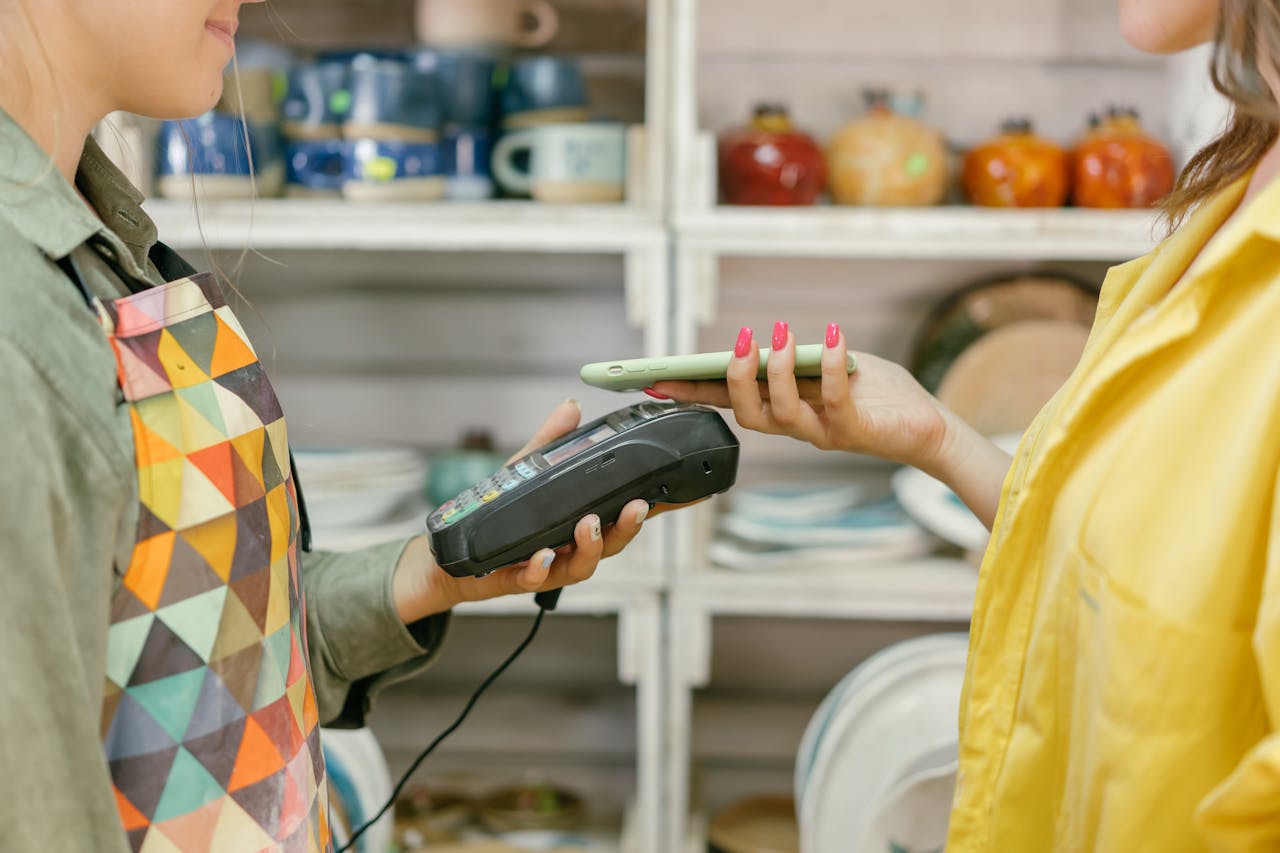Have you ever seen someone pay for coffee just by tapping their phone? That’s NFC payment in action—short for Near Field Communication. It’s a kind of “tap-to-pay” system that’s becoming more common every day.
No need to open an app, scan a code, or even have internet. Just hold your phone or smartwatch close to a payment terminal, and the whole transaction takes less than a second.
Here’s a quick overview:
| Feature | NFC Payment |
|---|---|
| Payment method | Tap and go (no contact) |
| Internet required? | ❌ Not needed |
| Security mechanism | ✅ Biometrics + Dynamic encryption |
| Supported devices | Phones, smartwatches, bank cards |
| Common use cases | Subway, supermarkets, cafés, gas stations |
How Does It Work? Breaking Down the Technology
NFC payments aren’t magic—they rely on several technologies working together to make it both fast and secure. Here’s what’s going on under the hood:
✅ NFC Chip: The “brain” of the device
Any NFC-enabled phone or watch (like iPhones, Samsung devices, Apple Watches) has an NFC chip inside. It allows the device to communicate wirelessly with a payment terminal at very short range (usually under 4 cm).
✅ Electromagnetic Induction: Contactless data transfer
NFC uses passive electromagnetic fields to initiate the connection and instantly transfer data. Since the range is so short, it’s almost impossible to eavesdrop.
✅ Encrypted Transmission: No “naked” data
All transaction data is fully encrypted during transfer. Even if a hacker intercepts the signal, they won’t be able to read or use the information.
✅ Tokenization: No real card number is sent
Modern NFC systems use “tokenization.” Instead of sending your actual card number, the device generates a one-time-use virtual token for each transaction. Even if stolen, it can’t be reused.
👉 Bottom line: When you pay, your phone and the terminal just “shake hands” for a split second. Your real card number? Never exposed.
Is NFC Payment Safe? 2025 Security Measures in the US & Europe
You might wonder: “If a tap is all it takes, what if someone steals from me just by getting close?”
Good question—but rest assured. As of 2025, NFC payments on major platforms are extremely secure. Here’s how the protection stacks up:
| Security Feature | Enabled? | Platforms Using It |
|---|---|---|
| Biometric ID + Device Binding | ✅ | Apple Pay, Google Wallet |
| Dynamic Token Technology | ✅ | Visa, Mastercard, Curve, etc. |
| Range + Timing Control | ✅ | Universal hardware standard |
| Payment Confirmation (Face/Finger) | ✅ | Enabled by default (small payments can skip) |
| Remote Device Wipe if Lost | ✅ | Supported on both iOS and Android |
📊 According to a joint 2025 report from Mastercard and the UK Fintech Association, NFC payment fraud is only 0.009%, compared to 0.15% for traditional magnetic stripe cards.
“Tap to Steal”? Common Myths About NFC Security
There are a lot of myths floating around about NFC payments. Let’s clear up a few of the most common ones:
❌ “I might get charged just walking through the subway?”
Nope. NFC only works within 4 cm. Plus, the terminal must initiate the transaction, and you must confirm it—usually with Face ID or fingerprint.
❌ “If someone taps my phone, can they take my money?”
Also no. Your phone must be unlocked, NFC must be on, and the transaction must be confirmed. It’s like using a card—you can’t just touch it and pay.
❌ “If I lose my phone, can someone spend my money?”
Not likely. With screen lock and biometrics enabled, no one can even open your wallet app. And you can remotely disable or erase the phone through “Find My Phone.”
👉 In short: Today’s NFC wallets are way harder to “hack” than you think.
Which Devices and Platforms Support NFC in 2025?
By 2025, NFC payments are widely supported. Here’s a breakdown of popular devices:
| Brand | Supported Devices | NFC Payment Support | Biometric Verification |
|---|---|---|---|
| Apple | iPhone 8+, Apple Watch Series 3+ | ✅ | ✅ Face ID / Touch ID |
| Samsung | Galaxy S8+, Galaxy Watch 3+ | ✅ | ✅ Iris / Fingerprint |
| Pixel 3 and up | ✅ | ✅ | |
| Fitbit | Versa 2 / Sense (Fitbit Pay) | ✅ | ✅ |
| Garmin | Vivoactive, Fenix 5+ (Garmin Pay) | ✅ | ✅ |
NFC vs Other Payment Methods: A Side-by-Side Comparison
| Payment Method | Contact Required? | Speed | Security Level | Offline Support | User Convenience |
|---|---|---|---|---|---|
| NFC Payment | ❌ No | ⭐⭐⭐⭐⭐ | ⭐⭐⭐⭐⭐ | ✅ Yes | Very high |
| QR Code Payment | ✅ Scan code | ⭐⭐⭐ | ⭐⭐⭐ | ❌ No | Moderate |
| Credit Card Swipe | ✅ Insert/swipe | ⭐⭐⭐ | ⭐⭐ | ✅ Yes | Moderate |
| Cash | ✅ Yes | ⭐⭐ | ⭐ | ✅ Yes | Low |
✅ Verdict: NFC leads in almost every category. It’s the closest thing to “tap and go.”
How Common Is NFC in the West? Real Usage & Urban Adoption
📈 According to Statista Q1 2025:
- 76% of Americans aged 18–35 use NFC payments at least once a week
- Subway systems in cities like London, Paris, and Berlin fully support NFC entry via Apple or Google Wallet
- In countries like Netherlands and Norway, nearly 90% of stores accept NFC tap payments by default
| Scene | Is NFC Common? | Why? |
|---|---|---|
| Subway / Public Transit | ✅ High | No tickets, just tap and go |
| Coffee Shops / Fast Food | ✅ High | Quick, no change needed |
| Supermarkets / Malls | ✅ High | Faster checkout during rush hours |
| Gyms / Gas Stations | ✅ Moderate | Often combined with member apps + NFC |
| Rural Shops | ❌ Low | Many still use cash or cards only |
The Future: Will NFC Replace Bank Cards Entirely?
In 2025, NFC isn’t just about replacing cards—it’s moving toward being your all-in-one digital identity.
✅ Digital IDs Are Going NFC
- In countries like Germany and Estonia, you can now load your ID or driver’s license into your phone (and verify with NFC)
- Several US states now allow NFC-enabled digital IDs for airport check-ins
✅ Cards Are Becoming Optional
- Banks like Revolut and N26 offer digital-only accounts—no physical card required
- NFC wallets now let you generate virtual cards instantly—no mailing delays
🧠 Prediction: In the next 5–10 years, bank cards won’t be necessary—they’ll be optional. NFC wallets will become the go-to tool for both identity and payments.
Should You Trust NFC Payments?
If you’re still on the fence about NFC payments, here’s the deal: they’re fast, secure, and already a huge part of daily life across the US and Europe. Whether you’re grabbing a coffee, hopping on the subway, or checking into a hotel—a simple tap is often all you need.
As long as you use basic security like Face ID or fingerprint unlock, NFC is actually safer than using a plastic card.
Try it once—and you’ll probably never want to swipe again.
Feel free to share it with a friend, leave a comment below, or bookmark it for later.
The way we pay is changing fast—don’t get left behind.



